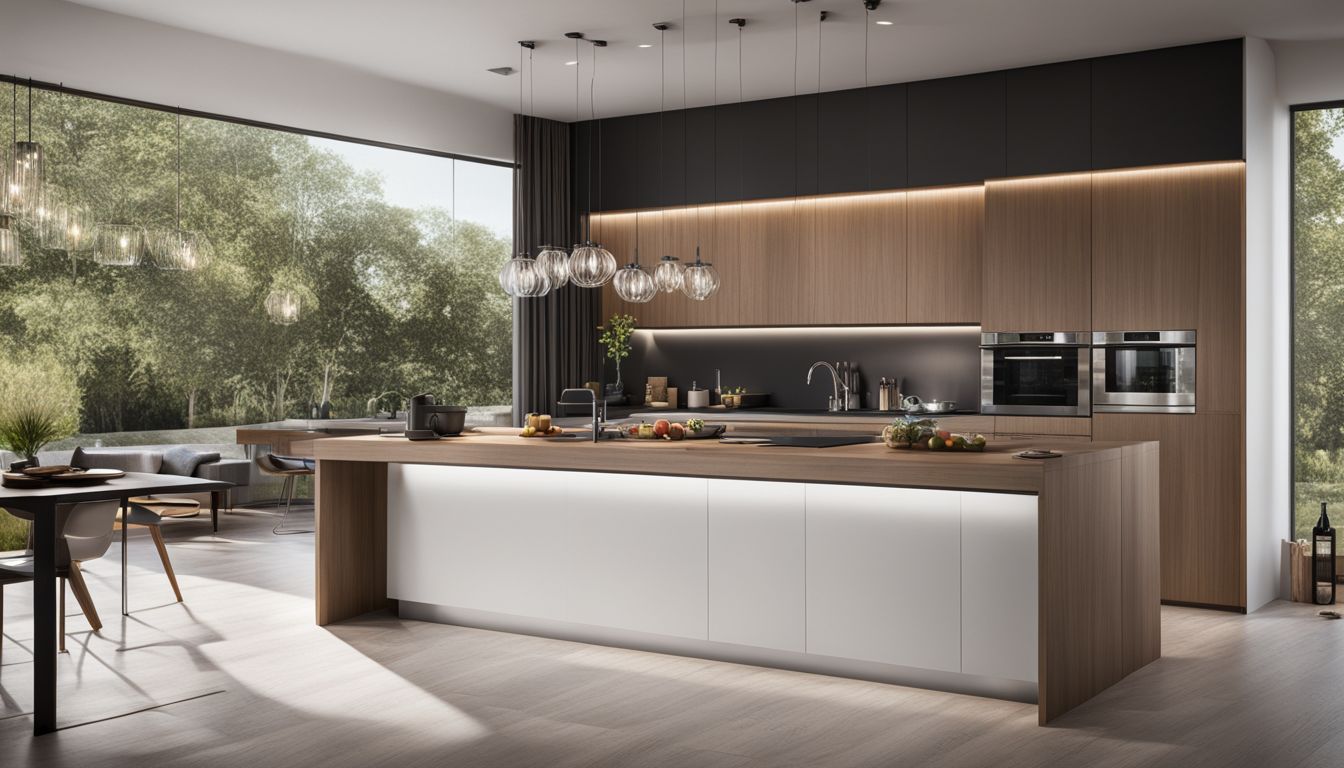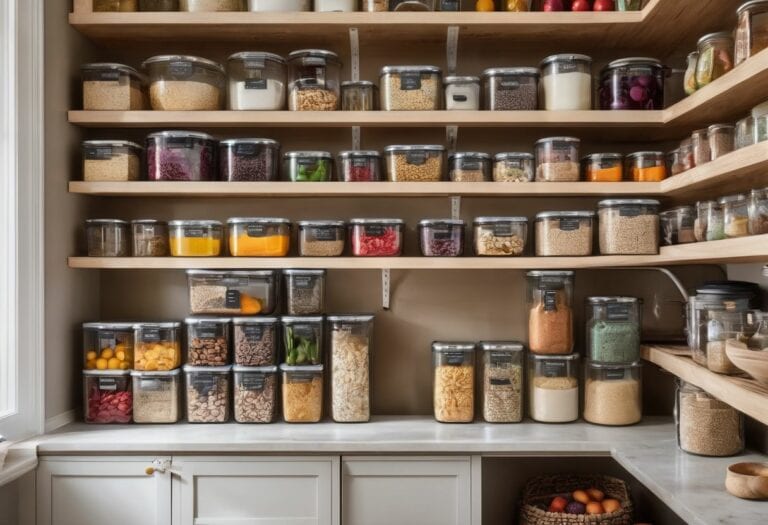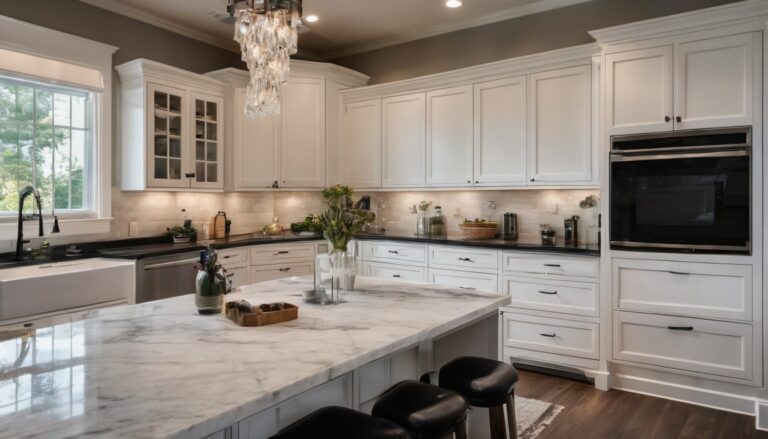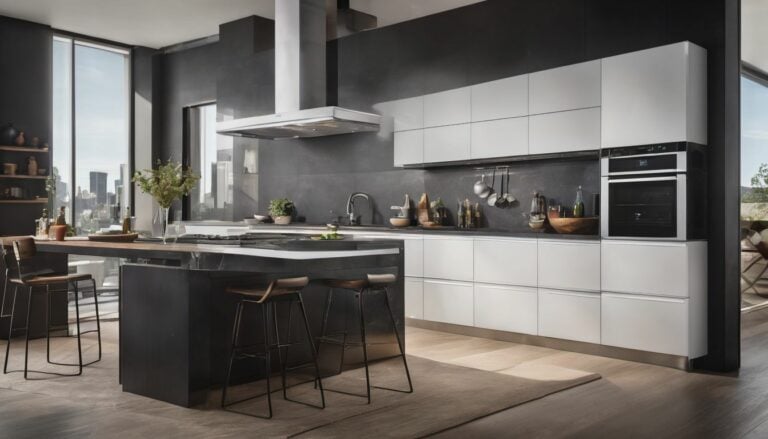Off-Center Kitchen Island: Can It Work?
Diving into a kitchen renovation can feel like quite the challenge, especially when figuring out the ideal location for your kitchen island – it’s something I understand totally because every inch matters in such a vital space.
Have you ever considered that while centered islands are popular, shifting them off-center could actually unveil an array of exciting design opportunities? So let’s delve into how positioning your kitchen island just a bit askew might be exactly what your cooking area needs and why straying from traditional placement might just work wonders.
Ready to break out of the box and explore some fresh perspectives?.
Key Takeaways
- Off – centering a kitchen island can provide design opportunities and maximize functionality in small kitchens or when incorporating unique features.
- Centering a kitchen island creates visual appeal and allows for equal distance to the sink from all sides, making meal preparation more efficient.
- Design alternatives to a centered kitchen island include centering on a feature, using two islands instead of one, or considering a peninsula.
- When determining the position of a kitchen island, consider the layout and flow of the kitchen and use templates or mockups for visualization.
- Factors to consider with an off – center kitchen island include sink placement and use, proximity to appliances, distance from seating area, and maximizing available space.
The Purpose of a Kitchen Island

A kitchen island is a useful piece of furniture. It gives you more room to cook and prepare food. You can chop up fruits, veggies, and other foods on its countertop. Underneath the top part, it has cabinets for storage.
Pots, pans, dishes or even food items can find a home there.
Kitchen islands are not just about function though. They add beauty to your kitchen as well. Free-standing islands fit in with the rest of your kitchen design nicely. Your guests will love how it looks!
The Benefits of Centering a Kitchen Island

Centering a kitchen island offers several benefits. It creates a visually appealing focal point in the kitchen, giving it a balanced and symmetrical look. Additionally, when the island is centered, it provides equal distance to the sink from all sides, making meal preparation and cleanup more efficient.
Visually appealing
A kitchen island in the middle is nice to look at. The design is balanced and symmetrical, meaning both sides are the same. This harmony can make a U-shaped kitchen more eye-pleasing.
Plus, it gives your kitchen a certain charm that grabs attention.
Large islands also look better when centered. They stand out and add beauty to the room’s overall feel. So remember, if you want a kitchen that looks good, try putting your island in the center!
Equal distance to sink
A centered sink in your kitchen island is perfect for cooking. This set-up adds style to your kitchen, as it looks balanced and neat. The best part? You can move around more freely! It’s easy to reach the stove or fridge from here.
Everyone can cook better with a central sink in their island. But be careful about space on both sides of the sink. There should be enough room for prep work too! Plus, the setback distance for the sink is important; two to four inches is just right.
When to Consider Off-Centering a Kitchen Island
Consider off-centering a kitchen island when dealing with limited space in a small kitchen or when incorporating unique features that require specific placement.
Small kitchen with limited space
In small kitchens with limited space, off-centering a kitchen island can be a smart choice. When there’s not enough room for a centered island, opting for an off-center design allows you to make the most of the available space.
By placing the island to one side, you can create better flow and maximize functionality in your compact kitchen. It also provides more options for storage and countertop space, helping you optimize every inch of your kitchen layout.
Adding an off-center island is a practical solution that enhances both efficiency and style in your small kitchen renovation project.
Inclusion of unique kitchen features
Incorporating unique kitchen features is a great reason to consider off-centering a kitchen island. By placing the island in an unconventional position, you can create a focal point that highlights architectural elements or showcases special design elements.
This allows you to customize your kitchen and add personality to the space. Whether it’s showcasing a statement hood or incorporating open shelving for display purposes, these unique features can make your kitchen stand out and reflect your personal style.
So don’t be afraid to think outside the box when designing your kitchen island and include those one-of-a-kind touches that make it truly special.
Design Alternatives to a Centered Kitchen Island
Instead of centering the kitchen island, there are several design alternatives that can create a unique and functional space.
Centering on a feature
When considering alternative placement options for a kitchen island, one option is to center it on a feature. This means aligning the island with a key work area or focal point in the kitchen.
By doing so, you can create a sense of balance and symmetry in your kitchen design. A centered island becomes a visually appealing centerpiece that draws attention and adds visual interest to the space.
It can also help create a harmonious flow between different areas of the kitchen, making it more functional and pleasing to the eye. So, if you’re looking for an alternative to a traditional centered island, consider centering it on a feature instead!
Using two islands instead of one
When designing a kitchen, using two islands instead of one can be a practical and stylish alternative. Having dual islands provides extra counter space, storage, and seating options.
It also allows for defined zones in the kitchen, making it easier to organize different activities. While two islands may not work well in all kitchen layouts, they can be a beneficial option in select situations where there is enough space.
Additionally, having multiple prep areas can make cooking and entertaining more efficient. Whether you’re looking for additional functionality or want to create a unique design element in your kitchen, considering two islands can offer practicality and aesthetic appeal to your space.
Consider a peninsula instead of an island
When designing your kitchen, it’s important to consider all the options available. If you’re thinking of adding a kitchen island but don’t want it to be centered, you might want to consider a peninsula instead.
A peninsula is an extension of your existing cabinets and countertops, creating more workspace and storage. Design professionals often see peninsulas as a great alternative to islands because they provide flexibility in terms of placement and can make better use of available space.
Keep in mind that peninsulas may require more patching and wall work compared to islands, so it’s essential to factor in the cost and any necessary modifications before making a decision.
How to Determine the Position of a Kitchen Island
Determining the position of a kitchen island is essential for an efficient and visually pleasing layout. Read on to discover practical tips and tricks for finding the perfect placement that suits your kitchen’s flow and style.
Consider layout and flow of kitchen
When determining the position of a kitchen island, it’s important to consider the layout and flow of your kitchen. Think about how people will move around in the space and how you can make it more efficient.
Take into account factors like where appliances are located, where cabinets and countertops are situated, and how you want to use your kitchen island. By carefully considering the layout and flow of your kitchen, you can ensure that your off-center island fits seamlessly into the overall design of your space while still maintaining functionality and convenience for all.
Use templates or mockups
When designing a kitchen island, it can be helpful to use templates or mockups. These tools allow you to visually explore different design options and determine the best position for your island.
Templates or mockups are cost-effective solutions that help prevent design mistakes and ensure optimal clearance in your kitchen. With these tools, you can analyze the available space, assess advantages and disadvantages, and make informed decisions before finalizing your kitchen island design.
So, consider using templates or mockups to create a functional and visually appealing kitchen layout that suits your needs.
Factors to Consider with an Off-Center Kitchen Island
When considering an off-center kitchen island, it’s important to think about factors such as sink placement, proximity to appliances, distance from the seating area, and maximizing available space.
But there are even more considerations to explore! Keep reading to learn how these factors can impact your kitchen design.
Sink placement and use
When it comes to the placement of a sink in a kitchen island, there are a few factors to consider. First, think about how you will use the sink. If you plan on using it for food preparation and cleaning up, you’ll want it to be easily accessible from all sides of the island.
Also, consider the proximity to your appliances. Having the sink near your stove and refrigerator can make cooking and meal prep more efficient. Another thing to keep in mind is the distance from any seating areas around the island.
You don’t want splashes or messes from washing dishes or fruits and vegetables to get on people sitting nearby. Finally, think about how best to utilize available space in your kitchen island design while still meeting your needs for countertop space and storage areas.
Proximity to appliances
When designing an off-center kitchen island, it’s important to consider the proximity to appliances. This means thinking about how close or far the island will be from your stove, refrigerator, and other kitchen appliances.
You want to make sure that there is enough space for you to easily access and use these appliances while also allowing for a functional and efficient workflow in the kitchen. Additionally, if your range hood is not centered with the island, it may require some careful planning and adjustments to ensure proper ventilation.
Overall, considering the relationship between your off-center island and your appliances is key in creating a well-designed and functional kitchen layout.
Distance from seating area
When positioning an off-center kitchen island, it is important to consider the distance from the seating area. Ideally, there should be 12 to 15 inches of space between the seating area and the height of the island.
This allows for comfortable legroom and ensures that people can sit comfortably without feeling cramped. It also provides enough space for people to move around and access the island without causing any disruptions during mealtime or social gatherings.
Keeping this distance in mind helps create a functional and enjoyable space for everyone in your kitchen.
Utilizing available space
When designing an off-center kitchen island, one important aspect to consider is how to utilize the available space effectively. Since the island may not have symmetrical cabinetry and drawers on both sides, it’s crucial to maximize storage opportunities.
This can be achieved by incorporating cabinets under the island overhang, providing additional storage options. By carefully considering the layout of your kitchen and making strategic choices about materials and design, you can create a functional and visually appealing off-center kitchen island that optimizes the use of available space while meeting your storage needs.
FAQs about Kitchen Island Placement
Are there any guidelines for sink placement on a kitchen island?
Should a sink be centered on an island?
When it comes to kitchen design, the decision of whether or not to center a sink on an island depends on various factors. It is generally considered ideal to center the sink on the island as it creates a visually appealing and functional design.
Centering the sink allows for good working space on both sides and avoids obstructing the pathway between important elements like the sink, stove, and fridge. However, there may be instances where aligning the sink with other elements in your kitchen layout makes more sense based on specific design goals and available space.
Ultimately, it’s important to consider both functionality and personal preference when deciding how to position your kitchen island sink.
Should an island be centered in the kitchen?
When deciding whether to center an island in the kitchen, several factors should be considered. While a centered island can create a visually appealing focal point and provide equal distance to the sink, it may not always be practical or feasible.
In smaller kitchens with limited space, off-centering the island can help maximize usable area. Additionally, if unique kitchen features such as a cooktop or specialized work area are desired, placing the island off-center allows for their inclusion while maintaining functionality.
Ultimately, the position of the island should be determined by considering the layout and flow of the kitchen and utilizing available space effectively.
Is it better to have a sink on the counter or in the island?
When deciding whether to have a sink on the counter or in the island, there are a few factors to consider. Having a sink in the island can create a more open and visually appealing kitchen design.
It also allows for equal distance between the sink and other areas of the kitchen, making it easier to work efficiently. However, having a sink on the counter may offer greater flexibility in terms of design options and storage space.
Ultimately, the decision should be based on your personal preference and how you use your kitchen space.
Final Thoughts on Off-Center Kitchen Islands
Consider functionality and design when deciding on an off-center kitchen island. Seek professional advice to ensure the best layout and flow of your kitchen. Remember that personal preference and style should also factor into your decision-making process.
To learn more about the benefits, design alternatives, and considerations of off-center kitchen islands, continue reading our blog!
Consider functionality and design
When considering the functionality and design of an off-center kitchen island, it’s important to think about how it will fit into your overall kitchen layout. The purpose of the island should align with your needs, whether it’s for extra storage, a prep station, or as a gathering space for family and friends.
Additionally, take into account the aesthetics of the island and how it complements the rest of your kitchen design. By carefully considering both functionality and design, you can create an off-center kitchen island that not only looks great but also enhances the efficiency and organization of your kitchen.
Seek professional advice
When it comes to designing a kitchen island, seeking professional advice can be incredibly beneficial. A consultation with an expert can provide you with valuable guidance and cost-effective solutions.
They have the design expertise to help you create a functional layout that meets your space requirements and personalized needs. By seeking professional advice, you can make informed decisions based on their recommendations.
This ensures that you avoid costly mistakes and create a kitchen island that not only looks great but also works well for your everyday use. So, don’t hesitate to reach out to professionals who can help bring your off-center kitchen island design ideas to life!
Personal preference and style
When it comes to kitchen island design, personal preference and style play a crucial role. Some people may prefer a centered island for its symmetrical look and balanced feel in the kitchen.
However, others may have a preference for off-center islands because they allow for more creativity and customization. Off-center islands can be a great choice for those who want to create unique focal points in their kitchen or who simply prefer asymmetrical designs.
With an off-center island, you have the flexibility to experiment with different layouts and add personalized touches that reflect your individual style. So whether you lean towards symmetry or love breaking design norms, choosing the position of your kitchen island based on personal preference and style can help create a space that truly feels like your own.
Conclusion
In conclusion, when it comes to kitchen design, an off-center island can be a viable and appealing option. It allows for more flexibility in layout and design choices, especially in smaller kitchens or when incorporating unique features.
By considering factors such as sink placement, appliance proximity, and available space, you can create a functional and visually pleasing kitchen with an off-center island. Remember to seek professional advice and consider your personal style preferences when making decisions about your kitchen island design.
FAQs
1. Can a kitchen island be placed off center in the kitchen?
Yes, a kitchen island can be placed off center in the kitchen to create a unique and functional design.
2. What are some design options when placing a kitchen island off center?
When placing a kitchen island off center, you can consider asymmetrical layouts, L-shapes, or incorporating it into an open concept floor plan.
3. Are there any considerations when positioning an off-center kitchen island?
Some considerations when positioning an off-center kitchen island include maintaining proper flow and clearance around the island, ensuring it doesn’t block other important areas or appliances.
4. What are the advantages of having an off-center kitchen island?
Having an off-center kitchen island allows for more space to move around and creates interesting visual focal points in your kitchen design.
5. Do I need to consult with a professional for designing an off-center kitchen island?
It is recommended to consult with a professional designer or contractor who specializes in kitchens to ensure that your layout is functional and meets building codes and safety requirements.







